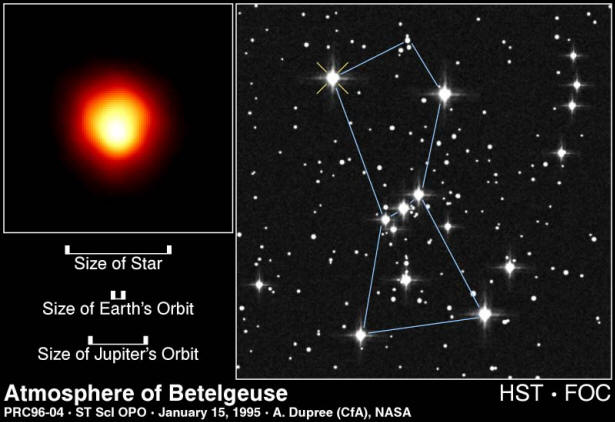Two
bright regions visible in recent
astronomical observations of the
massive star's surface provide more
evidence for the Electric Star
theory.Betelgeuse is one of
the largest stars in the observable
Universe. If it was placed in the
Sun's position, it would be larger
than Jupiter's mean orbital
diameter. However, the star's
material structure is so diffuse
that the orbits of the inner
planet's might not be affected at
all.
Betelgeuse is the upper left star
in the constellation Orion, also
notable for the Orion Molecular
Cloud Complex, a topic of several
previous Picture of the
Day articles. The star is considered
youthful by consensus astronomers,
but nearing senescence because its
extravagant radiative output exceeds
100,000 times that of our Sun.
According to a recent
press release, sunspots
have been found on the surface of
the stellar behemoth. However, there
are only two of them occupying over
one-third of its surface, and are
said to be the signature of heat
transfer from the interior through
"matter convection". As the report
suggests, the star is acting like a
pot of boiling water—a strictly
mechanical phenomenon.
Betelgeuse is notable for
gigantic "bubbles of hot gas" that
are in constant motion—bubbles as
large as the star itself. Since it
has been observed to eject massive
amounts of stellar material, greater
than six-times its diameter, it has
been proposed that Betelgeuse is
undergoing violent vertical
oscillations just beneath its
surface. It is that energetic motion
that is causing the "hot gas" to
blast into space, just as bubbles in
boiling water erupt with puffs of
steam.
The Electric Star theory provides
another explanation. An explanation
that relies on the electrical
connection stars have with their
galactic neighborhood, and with the
Universe. Stars shine because
electricity flows through each
galaxy. As has been written in these
pages many times, stars can be
thought of as giant spheres of
slow-motion lightning. It is this
simple hypothesis that best matches
observational evidence.
Retired Professor of Electrical
Engineering Don Scott wrote in his
acclaimed book
The Electric Sky that a
star's size, luminosity, and color
have little to do with its age.
Stars fall into position on the
Hertzsprung-Russell diagram because
of the input they receive from
galactic electrical circuits. As Dr.
Scott wrote, the primary indicator
for a star's behavior is the current
density at its surface. Stars do not
rely on internally generated fusion
fires to supply them with energy.
Red giant stars are relatively
cool but extremely bright, so they
are interpreted to be quite large.
Scott proposes that the "giant"
characteristic is a result of an
exceptionally broad corona and not
because the stellar disc is
oversized. The star might be small
inside its extended, energetic
atmosphere. The fact that Betelgeuse
has a temperature measurement of
about 2900 Celsius calls into
question the thermonuclear model of
stars. How can such cool
temperatures create a radiative
output that is so extreme?
Physicist and Electric Universe
advocate
Wal Thornhill also
proposes an electrical model for
Betelgeuse, and red supergiant
stars, in general. Electric currents
in space are primarily due to the
flow of electrons through
interstellar plasma, and not the
movement of positive ions. This
means that stars are lacking in
electrons because of a charge
separation process. Stars can be
considered "positive anodes in a
galactic glow discharge." Therefore:
“Red stars are those stars that
cannot satisfy their hunger for
electrons from the surrounding
plasma. So the star expands the
surface area over which it collects
electrons by growing a large plasma
sheath that becomes the effective
collecting area of the stellar anode
in space. The growth process is
self-limiting because, as the sheath
expands, its electric field will
grow stronger. Electrons caught up
in the field are accelerated to
ever-greater energies. Before long,
they become energetic enough to
excite neutral particles they chance
to collide with, and the huge sheath
takes on a uniform ‘red anode glow.’
It becomes a red giant star."
Betelgeuse is an electric star,
and the bright regions are areas
where electric currents are flowing
with the greatest Amperage.
Stephen Smith







